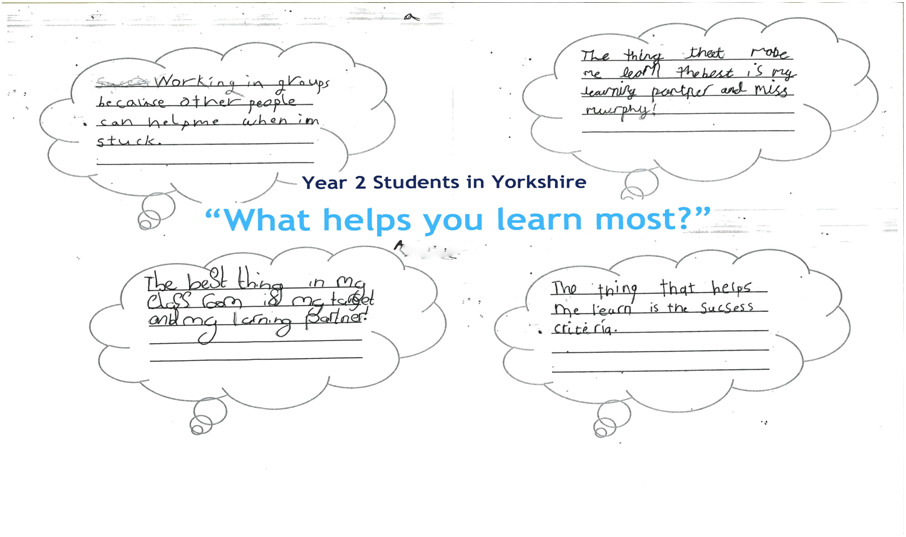
Research
with school students: four
innovative methods used to explore effective teaching
Jessica
Faye Heal, Teach First and the University of Manchester
Abstract
This
article outlines
the need for innovative research methods and discusses four approaches
employed
within an educational setting to enhance how students between the ages
of 5-18
years old engage in research exploring effective teaching. It draws on
upon Article
12 of the
United Nations Convention on the Rights of the Child, focussing on the
'space'
in which the research is conducted and the 'voice' of the child.
Through two
techniques to scaffold the semi-structured interview, a child-led
classroom
tour and a 'draw-and-tell' style method, the
researcher-participant
power imbalance is interrupted. Their efficacy to disrupt lies in the
following
unifying characteristics: providing familiarity to the student,
situating the
student as an expert and giving the student choice.
Keywords: innovative
research methods; young people; education; interviews; draw and tell;
child-led; child rights, primary, secondary, student voice
Introduction
As
a doctoral researcher, ex-language teacher and full time qualitative
researcher
at Teach First, students are at the heart of what I do and the reason I
do what
I do. Since my undergraduate days, I have been passionate about
bringing
unheard voices to the fore, and for the last seven years I have been
working
with young people from the poorest backgrounds that our society
consistently
ill-considers and ignores.
The
opinions and perceptions of these students are of central importance to
how we
recruit, train and support our teachers at Teach First. This article,
adapted
from the Inequality in Education - Innovative conference presentation,
highlights why the student voice is such an important issue and then
outlines
four methods that enhance how students participate in our research.
Although
conducted within an educational setting, these methods are transferable
for use
with children and young people more broadly and the citations and
language reflect
this. Working in compliance with Article 12 of the United Nations
Convention
Rights of a Child, these methods aim to disrupt the
interviewee-interviewer
power balance by providing choice, ownership and familiarity. These
methods are
arguably effective in supporting students to make informed and valuable
contributions to research into effective teaching.
The
project overview
Over
the past year, interviews have been conducted with 124 students, 21
teachers
and 20 mentors in order to explore what appears to be making their
classroom a
successful learning environment. The teachers are purposively sampled
through a
combination of data and recommendations from those who work closely
with them.
They, in turn, then put forward a selection of higher, middle and lower
attaining pupils for us to work with. After data collection, a thematic
analysis is conducted and the findings from this inform how we recruit,
train
and support new teachers.
However,
there is a tension in using the word ‘effective’
– this positivist term sits
quite uneasily within our qualitative, more intepretivist research.
This is a
product of our industry, conducting researching within a sector where
‘impact’,
and the measurement of it, accounts for substantial funding income.
Within this
institutional imperative, we aim to craft a space within which valuable
qualitative research can be carried out. This is through the loose
interpretation of the word ‘effective’ to mean
‘standing out as a teacher that
the education community is able to learn from’. To explore
which elements of
teacher practice should be learnt from, it is paramount to seek to
understand
what students feel they most benefit from – they are the ones
currently
experiencing a variety of different classrooms and are therefore most
attuned
to how they learn.
Why
we need different research methods
The
UNCRC Article 12 states all young people have the right to be heard,
and that
their voice must be given ‘due weight’ in matters
which concern them. This
contributes to this paradigm shift in research design in social
science, moving
from merely respecting participants to a considered, contextual and
culturally
sensitive approach (Suinn, 2006). In line with this development, the
academic
community has an ethical obligation to uphold this paradigm when
conducting
research with students.
Designing
research which works within the principles of article 12 has been
explored in
depth by Lundy who posits that you need to go beyond the stated
requirements in
order to fulfil them, ensuring students:
- Can express
their voice through
whichever medium they prefer
- Have a safe and
inclusive space to
form and express a view
- Have an
audience that will listen to
the view
- Hold views
which will be of
influence and acted upon
(2007;
2013: 2)
It is our responsibility to create an environment to ensure students feel empowered: conducting research with students, not about them (Thompson, 2009). This comes from the premise that 'we desire to position children as social actors who are subjects, rather than objects of inquiry' (Christensen and James, 2008: 2). The work of the researcher can be compared to work of a gallery curator — it is the students who are the masters and experts of their situation and the role of the researcher is to ensure the gallery doors are open and it is teeming with an audience who leave affected. This is where the four methods come in, facilitating the creation of these oeuvres.
Four
approaches to support student voice
The
methods below focus on supporting the ‘voice’ and
‘space’ elements of Lundy’s
Article 12 framework (2013). Methods one and three scaffold the
traditional
semi-structured interview through a pre-task and using student work as
a
prompt, method two is an exploratory child-led tour of the classroom
and the
last is a creative research method. Looking beneath the surface of each
method,
they share the following qualities:
-providing
students choice
-enabling student
ownership
-structuring the
interactions within familiarity
-disrupting the
interviewer-interviewee power balance
Redressing
the power balance in an interview situation is a key issue when
conducting
qualitative research because the power
relations that emerge in interviews are embedded
within the data they produce (Briggs, 2003). With young people and
vulnerable
groups, this is an even greater issue because the imbalance between
interviewer-interviewee is exacerbated (Morrow
and Richards, 1996, Edger and Fingerson, 1999). Lincoln
and Guba (1985), Denzin and Lincoln (2000) and
Flick (2002) all highlight the need for researchers to be vigilant to
ensure
that the participants feel comfortable to speak in a voice that is
authentic.
Logistically,
interviewing students generally takes place in pairs. This not only
acts as a
physical shift in the power ratio, 2 interviewees: 1 interviewer, but
also
reduces participant discomfort and helps them to build on ideas as a
pair. This
has been shown to create an environment where participants are more
animated and
give more substantiated, nuanced and comprehensive answers (Lohm
and
Kirpitchenko 2014).
Pre-interview
tasks

Figure
i: Four examples of student
learning bubbles
The
day before the visit, a Year 2 Class in Yorkshire (ages 6-7) were asked
to fill
in a learning bubble, answering the question ‘what helps you
learn most?’.
Learning bubbles were a familiar classroom tool, which the teacher used
regularly to help the students reflect on their learning; this meant it
was a medium
of communication they already knew how to engage with. It should be
noted that
with any regular classroom activity considering ‘school
genres’, implicit rules
and regulations could be acting upon the students’ engagement
in the activity
(Moss, 1989).
The
students’ responses were collated and used to inform the
research in two ways.
Firstly, they supported the group interview as using pedagogic language
familiar to the students mitigated issues highlighted by Sarah Punch;
when
adults and children use a vocabulary or language style which is
unfamiliar to
the other (2002). This communal understanding of language allows both
the
interviewer and students to access the conversation. For instance, the
extract
below shows students explaining a particular concept they had
referenced on
their learning bubble.
JFH:
Okay, so one thing it says here is that your learning partner helps you
learn.
What is a learning partner?
Trey:
It’s a partner that helps you learn. If you’re
stuck on anything, you can’t do
it by yourself, then you have to go with a partner.
Jenny:
They help you a lot.
Leyla:
If you’re stuck, you ask your learning partner, and if your
learning partner is
stuck with you asking a question, you ask the teacher instead.
Trey:
Everyone’s in it together, you’re not by yourself.
This
interview extract shows the underlying feelings students have around
their
class ethos and the sense of security it affords. This method gives
students
time to prepare, is sensitive to their experience and empowers them to
talk
about the situation (Gallagher, 2008). Fundamentally, it gives them
ownership
of the discussion by building on their previous learning bubble
answers. A
secondary benefit of the pre-interview task is that it enables the
collation of
answers from the whole class, providing a broader snapshot of how the
class
feels about their learning. It’s striking that two thirds of
the class, in this
example, gave an answer which was not their teacher; suggesting that
certain
pedagogical strategies could help to build student independence.
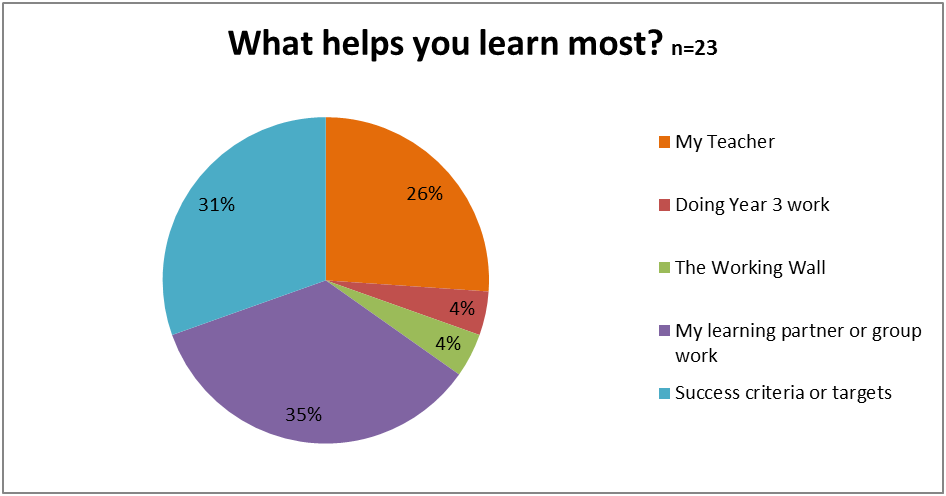
Figure
ii: Whole class response to the
question ‘what helps you learn most?’
Classroom
Environment
‘The
use of child led tours privileges the ways that young children
communicate, in
active, visual ways’ (Clark, 2010: 117).
A
student from the same Year 2 class conducted a tour of his classroom,
the
researcher then films the classroom displays that helped the student
learn
most: the ‘progress train’ on the display board
[figure iii] and his target
stuck onto his table [figure iv]. The student had ownership over the
data
collected, an expert within a familiar environment who had the choice
of where
to go and what to discuss. The tour was fully child-led and, although
Trey was
not operating the camera himself, he directed where it should be
pointed. This
approach opens up a new communicative space which provides a window
into the
classroom through the eyes of a student. This child-led approach
reveals a new
angle for teachers and educationalists to understand how students
perceive and
value their environment (Clark, 2010: 122).
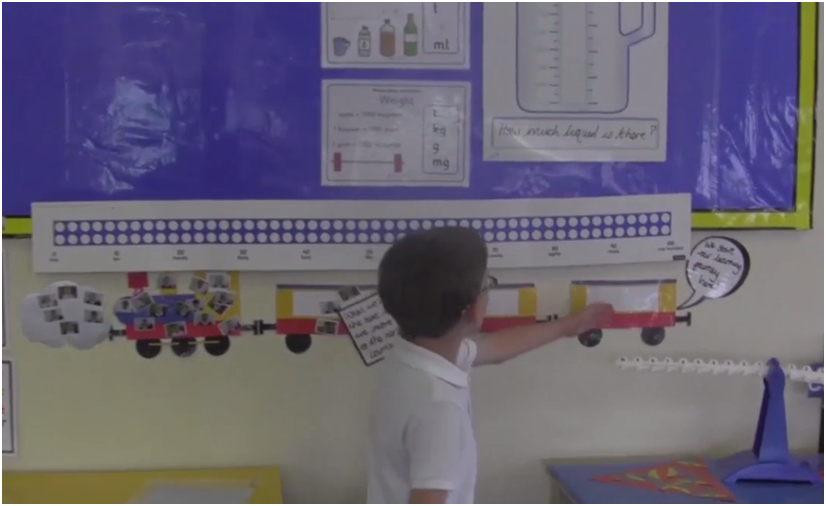
Figure
iii: Screen shot of the
‘progress train’ which Trey wanted to show me
because it helps him learn if he
knows where he is on the train.
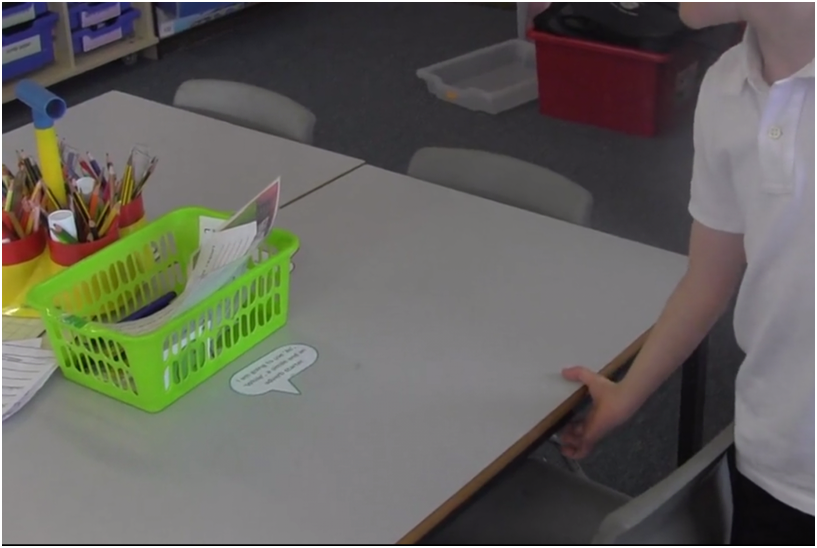
Figure
iv: Screen shot from filmed
class tour, this image shows Trey discussing his target and how he
finds it
useful as a reminder of what to focus on
The
classroom tour, pre-interview task and semi-structured interview
combined with
classroom footage of teaching and learning, is reminiscent of the
multi-method
Mosaic Approach developed by Clark and Moss (2004). The
multi-faceted method is designed to help adult
researchers who wish to listen to young children's perspectives by
capitalising
upon young children's competencies (Kay, 2009). It enables a broader
and deeper
picture of the classroom to be drawn, giving us multiple materials to
both
analyse and then share with those who can learn and act upon it.
Student
work
School
work has be found to be a useful prompt for secondary school age
students
during the semi-structured interview. The use of student work developed
the
interview into a more exploratory conversation through revealing deeper
reflections, perceptions and subjective understandings of student experience. The example below,
featuring two Year 7
students (ages 11-12) discussing how their teacher marks their books,
highlights how it can ‘uncover unarticulated informant
knowledge’ (Johnson and
Weller, 2001: 491).
Amy: She gives us
comments and because on mine, I spelt something wrong
and I didn’t do all of the accents on the tops of the words,
she will write
comments like, be careful with spellings and try and make your
sentences longer
and don’t forget your accents. She will give you
levels…She will give you bit
to fill in…You have to do how you felt about your work like
circle them and
explain how you felt. Then Miss put I did good work and she
didn’t put spelling
that much she just put punctuation because I miss a lot of the accents
out.
Ben: ...Once
we know what we are struggling on we can improve it and
that we need to improve on that and that helps us get our work to be
almost
perfect.
JFH:
That is really interesting,
because you enjoy the fun stuff but that is not a fun thing but like
you said
it helps you. Can you explain that in a way that? What could a new
teacher
learn from that?
Ben:
Try to use comment much as
you can because if someone in your class is struggling…
Ben:
…Also it helps because say
that someone is struggling in class and they don’t want to
speak out loud to
the teacher, they can write it down like a small message. Once the
teacher has
got it they can think – they will look everyone is work and
if most people put
the same thing she has then got like a lesson plan that we can do.
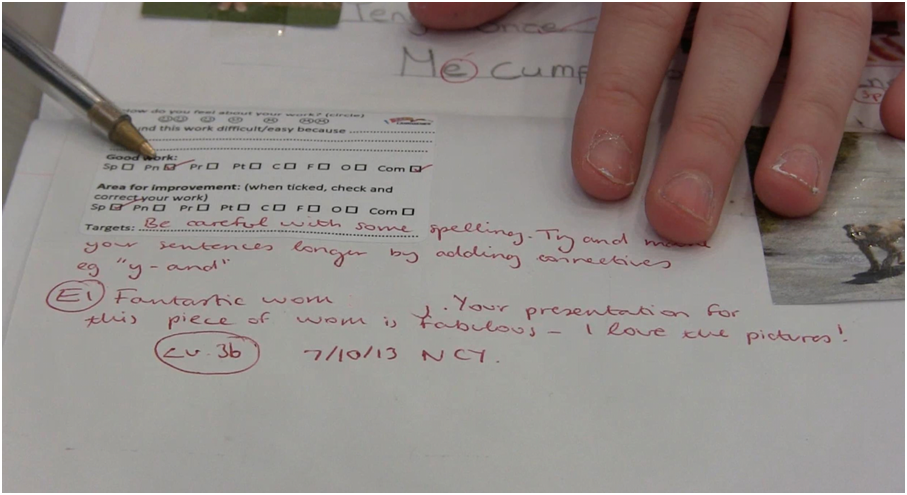
Figure
v: Screen shot from interview
of students discussing how their work is marked by the teacher
The
conversation veers into
deeper personal reflections, such as how they improve and how the
teacher has
reduced the discomfort caused by asking for help within the classroom
setting.
This
method,
although logistically different, acts in a similar way to the
pre-interview
task approach. It acts to redistribute the power balance between
interviewer
and interviewee by centering the conversation on an item that is
familiar to
the students and related to their personal experience, which enables
them to
confidently be experts. These methods, however, rely on a key factor:
students
feeling comfortable enough to overcome the power imbalance of talking
to a
relative stranger and, in some cases, on camera.
This
last section will move onto discuss a method employed to be
inclusive of those who are keen to express themselves through a
different
medium.
Draw
and tell
Alongside
other creative methods, draw and tell was developed in order to
maximise
student participation in research by offering an alternative to
traditional
data collection instruments. Emerging in an early form as 'draw and
write' in
the health research field in 1972, it was noted six and seven year olds
were
able to better draw their feelings and emotions, than articulate them
(Wetton,
1999).
The
draw and tell method has been employed with Primary students who do not
feel
comfortable talking with us. These pictures below are snapshots from a
drawing
created by Amaan, a Year 3 (ages 7-8) student from Birmingham, who was
sat on
the lower attaining table. Amaan was very shy and uncommunicative so I
asked if
he could draw a picture of his classroom and what he likes about it.
Once he
began drawing, I then asked 'can you explain this to me?' about each
part of
his picture as he drew, noting down his account verbatim. I then
annotated his
drawing with his explanations.
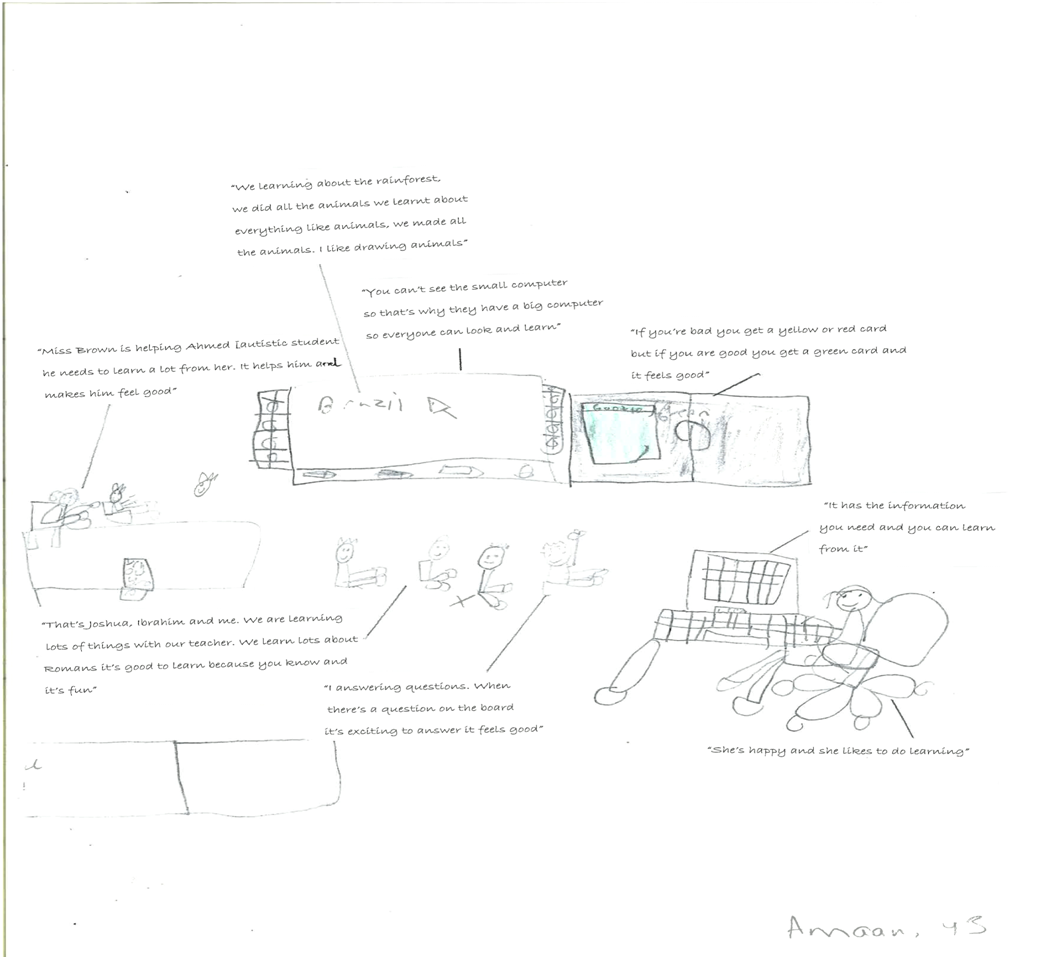
Figure
vi: Year 3 Student draws their
class and explains each picture
This
method is particularly effective in allowing students to take time to
think,
building their answer in stages rather than needing to provide an
immediate
response (Gauntlett, 2004). As Angell stated, this approach goes some
way to
equalising the ‘power imbalances’ between adult
researchers and children: as it
offers ‘each child an opportunity to subtly negotiate their
own level of
participation’ (2014: 10).
Conclusion
‘We
tried to make the children experts in their own
lives, and to inform them that this was the case. Many of the children
were
clearly unused to being regarded as the most important sources of
information
about their own lives in this way- certainly by an adult they hardly
knew’
(Langsted 1994: 35)
It is
within these drawings, interviews and tours that I hope our research
goes
beyond Article 12 in providing the opportunity for all students
– irrespective
of any measure or label – to influence their experience and
the experience of
other students across the UK.
The
data we create with students has become more nuanced and powerful in
its
ability to influence through having the following qualities:
-providing
students choice
-enabling student
ownership
-structuring it
within familiarity
-disrupting the
interviewer-interviewee power balance
Whatever
shape the method takes, if it considers these elements it can make a
valid
contribution to the students, the researcher and the organisation it
aims to
influence. Using these methods
has provided accessible
and realistic representations of student experience and has been used
in
analysis to enhance how teachers understand students and what they
perceived as
important. It brings the classroom to the organisation in such a
measure that
traditional interview copy cannot compete.
The
four methods outlined aim to be a tool for researchers to scaffold
their
approach to support and situate students as the experts of their
situation. The
more students are empowered, the better the data and therefore the
easier it
becomes for this voice to influence policy and strategy. And, just like
the
classroom pedagogy, the more time you invest in thinking about the
students you
want to work with, the more they will invest in you.
Acknowledgments
Thank
you to Teach First and the University of Manchester for advice and
support and
to all the students and teachers who welcomed me into their classrooms.
Lastly I’m
grateful to Siobhan Dytham and Carli Rowell for organising such an
interesting
conference and giving me the opportunity to present.
List
of Illustrations and Graphs
i.
Student
Learning Bubbles
ii.
Pie
chart of ‘What helps you learn most?’
iii.
Screen
shot from video of classroom tour
iv.
Screen
shot from video of classroom tour
v.
Screen
shot of student work
vi.
Drawing
from interview ‘what’s your class like?’
References
Angell,
C., Alexander, J., and Hunt, J. A. (2014), ‘Draw, write and
tell’: A literature
review and methodological development on the ‘draw and
write’ research method, Journal
of Early Childhood Research, August, 1-12
Briggs,
C. (2003), ‘Interviewing, Power/Knowledge and Social
Inequality’ in Jaber F.
Gubrium, and James A. Holstein (eds), Postmodern Interviewing,
Thousand
Oaks: Sage, pp. 242-55
Christensen,
P., & James, A. (Eds.). (2008). Research
with children: Perspectives and practices. Abingdon:
Routledge.
Clark,
A. (2004), ‘The Mosaic Approach and Research with Young
Children’, in Lewis.
V., Kellett, M., Robinson, C., Fraser, S., and S. Ding (Eds), The
Reality of
Research with Children and Young People. London: Open
University pp.
142-161
Clark,
A. (2010), ‘Young children as protagonists and the role of
participatory,
visual methods in engaging multiple perspectives’, American
Journal of
Community Psychology, 46(1-2), 115-123
Denzin,
N.K. and Lincoln, Y.S., (2000), Handbook of Qualitative
Research, 2nd Edition.
London: Sage.
Flick,
U. (2002), An Introduction to Qualitative Research,
London: Sage.
Gallagher,
M,, (2008), ‘Data Collection and Analysis’ in Tisdall,
K., Davis, J. M., and Gallagher,
M. (eds). Researching with children and young people:
Research design,
methods and analysis, London: Sage, pp. 65-77
Gauntlett
D., (2004) Using new creative visual research methods to understand the
place
of popular media in people’s lives. Paper presented at the
IAMCR, Porto Alegre,
Brazil, 25–30 July, 2004
Johnson,
J, and Weller, S., (2001), ‘24 Elicitation Techniques for
Interviewing’, in
Jaber F. Gubrium, and James A. Holstein (eds), Handbook of
Interview
Research, Thousand Oaks: Sage, pp. 491-515,
Kay,
E., Tisdall, M., Davis, J.M., and
Gallagher, M (2009), ‘Glossary of Terms’, Researching
with children and young
people: Research design, methods and analysis,
London: Sage, pp.
223-31
Langsted,
O., (1994). ‘Looking at quality from the child’s
perspective’, In Moss, P.,
& Pence, A., (Eds.), Valuing quality in early
childhood services: New
approaches to defining quality (pp. 28–42). London:
Paul Chapman.
Lincoln,
Y.S. Guba, E.G., (1985), Naturalistic Enquiry.
London: Sage.
Lohm,
D. and Kirpitchenko, L. (2014), ‘Interviewing Pairs:
Discussions on Migration
and Identity’, in
Research
Methods Cases, London: Sage
Lundy,
L., (2007), ‘Voice is not enough: Conceptualising Article 12
of the United
Nations Convention the Rights of the Child’, British
Educational Research
Journal, 33(6): 927–942
Lundy,
L and Welty, E., (2013), ‘A children’s rights-based
approach to involving
children in decision making’, Journal of Science
Communication, 12(03),
pp. 1-5
Moss,
G., (1989), Un/Popular Fictions. London: Virago.
Morrow,
V., and Richards, M., (1996), ‘The ethics of social research
with children: an
overview’, Children & Society 10:
90–105.
Punch,
S. (2002), ‘Research with children: The
same or different from research with adults?’. Childhood, 9(3),
321-341.
Suinn,
R., (2006), 'Preface', in Trimble, J.E., and Fisher, C.,B (Eds.) The Handbook of Ethical
Research with Ethnocultural
Populations & Communities, Thousand
Islands: Sage.
Thomson,
P. (Ed.).
(2009), Doing visual research with children and young
people. London:
Routledge.
United
Nations Committee on the Rights of the Child, (2009), General Comment
no. 12,
The Right of the Child to be Heard (CRC/C/GC/12), http://www.refworld.org/docid/4ae562c52.html, accessed
17/10/14
Wetton, N.
(1999), Draw and Write.
Health Education Unit. Southampton: University of Southampton.